Bathroom conversions are the cure for outdated or dysfunctional bathrooms. Whether you want to improve the accessibility of your bathroom or swap out your unused bathtub for a new walk-in shower, a bathroom conversion specialist can help you achieve your goals.
Most people spend 30 to 60 minutes in their bathrooms each day. It’s worth the effort to learn everything you can about making upgrades before you dive into a bathroom conversion project.
In this big bathroom conversions guide you’ll discover:
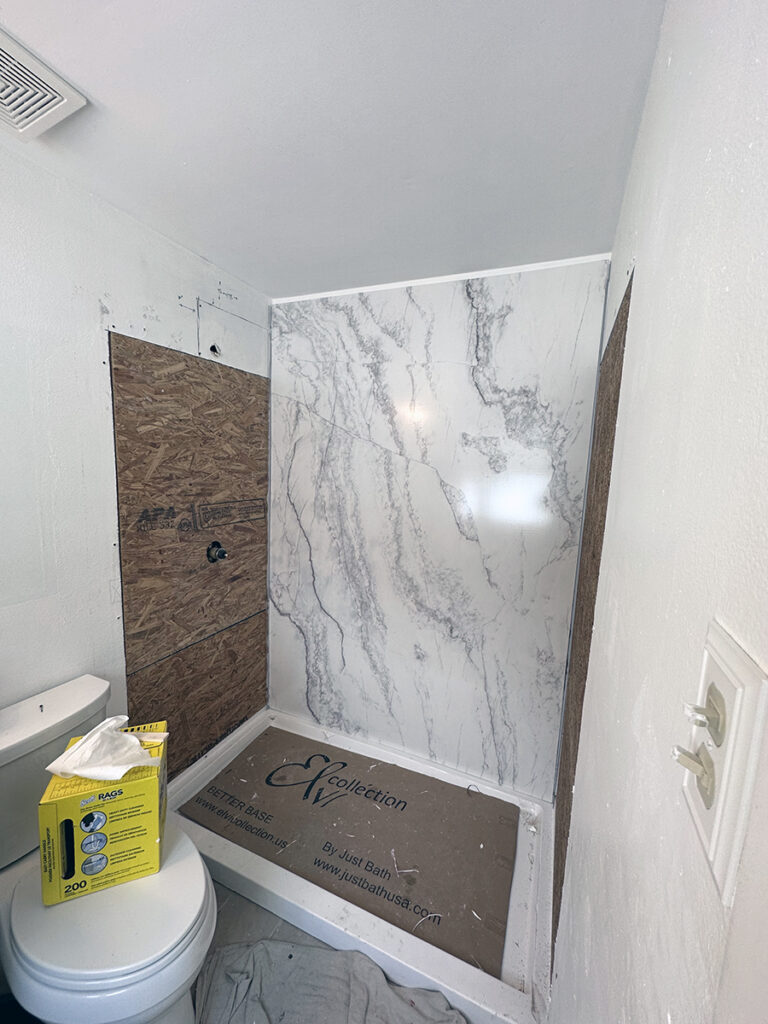
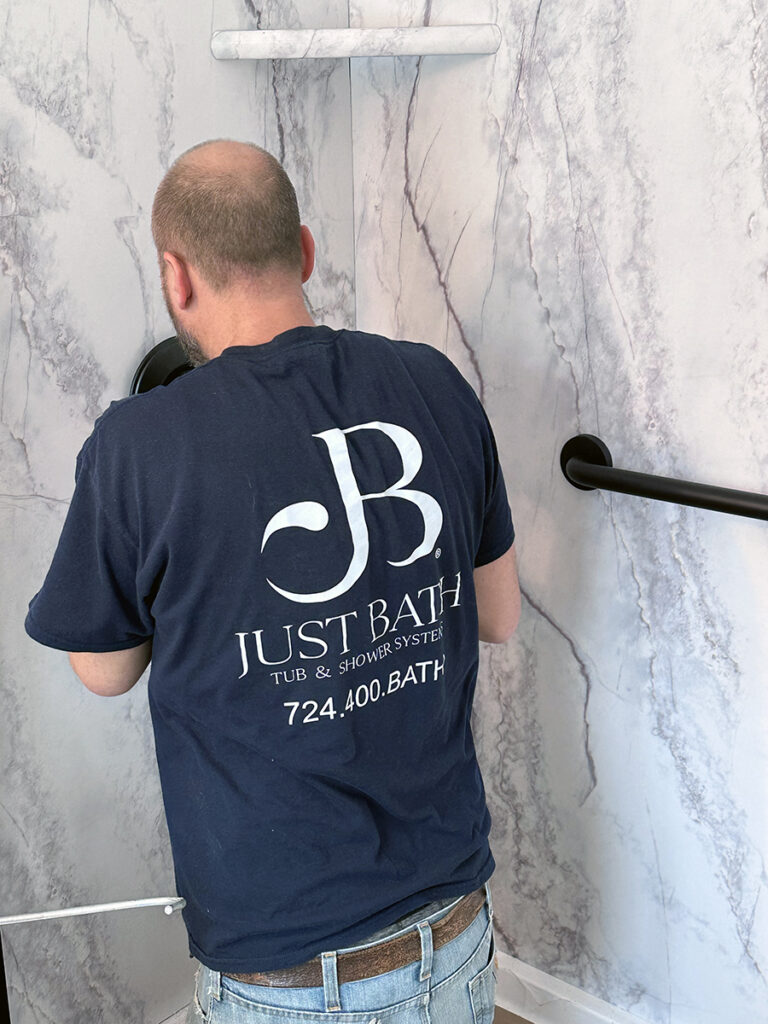
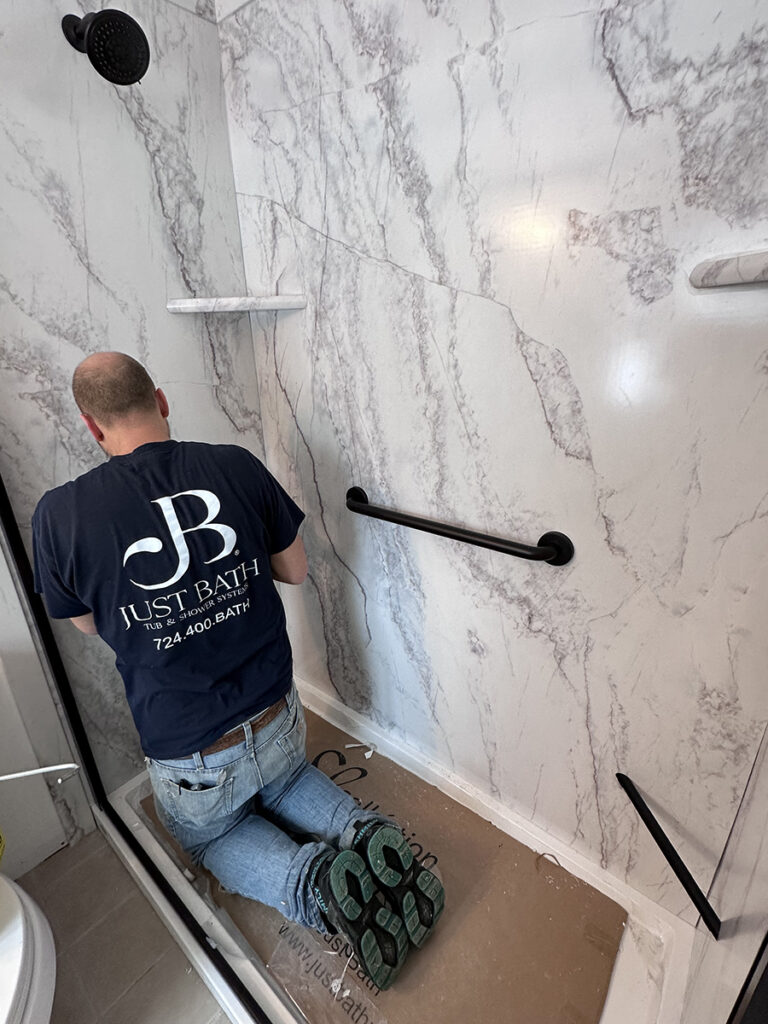
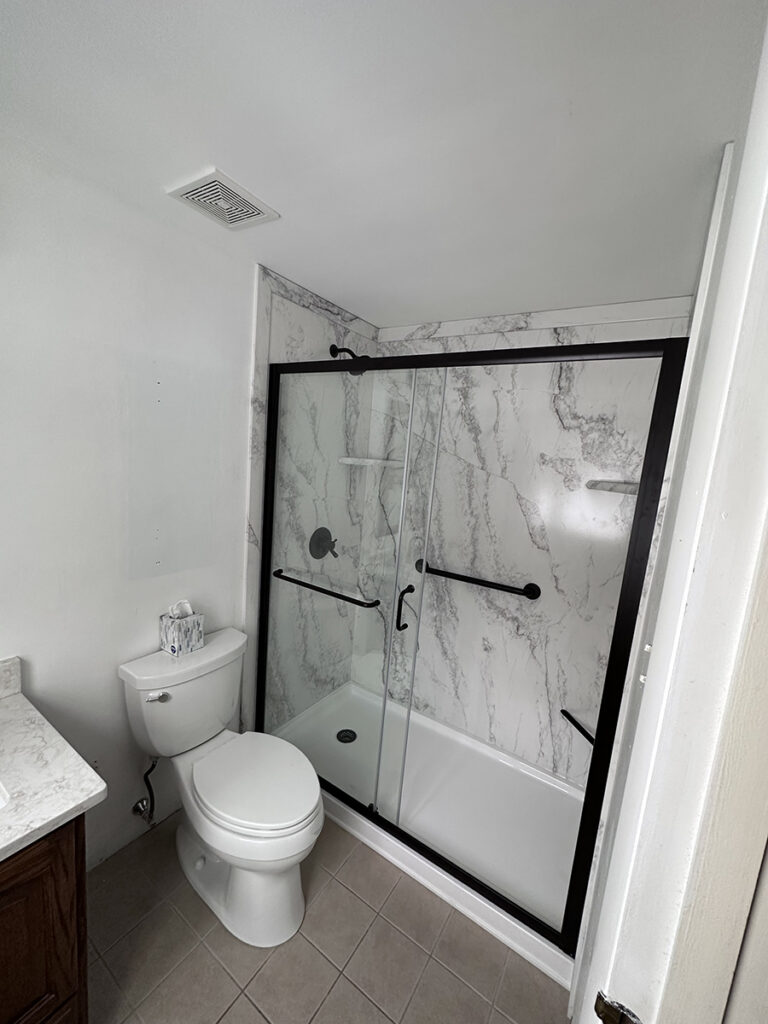
A bathroom conversion is the process of transforming an existing bathroom into a new and improved space. You can update the design to improve accessibility or functionality.
Some people convert unused bathtubs into walk-in showers. Others install walk-in bathtubs so they can enjoy bubble baths again without the fear of slipping and falling getting in and out of a tub.
Creating a more functional, efficient, and visually-appealing space that meets your specific needs is the primary goal of bathroom conversion.
Ultimately, the scope of the project depends on your goals, budget, and the condition of the existing bathroom.
Turning your tub into a walk-in shower is an increasingly popular bathroom conversions project. Some homeowners make the switch because they prefer the convenience and sleek appearance of a walk-in shower.
Others are more concerned with improving the safety of their bathroom space with tub-to-shower bathroom conversions. Bathrooms are the most dangerous room in the house, especially for slips and falls. You can eliminate the risk of tripping over a high-sided bathtub by replacing it with a walk-in shower.
Besides improving accessibility and safety, some other benefits of turning your tub into a shower include:
How much it costs to convert a tub to a walk-in shower depends on several factors. The size and complexity of the project and the materials used are two of the biggest influences on price.
A simple conversion project involves removing the old tub and installing a prefabricated shower pan and basic fixtures. Conversions that include custom tile work, additional plumbing or electrical, or the relocation or enlargement of the existing space can increase costs significantly.
You can get an instant quote for a basic bathroom conversion project with Just Bath on our website. Just plug in your bathroom dimensions and choices and we’ll provide a cost estimate.
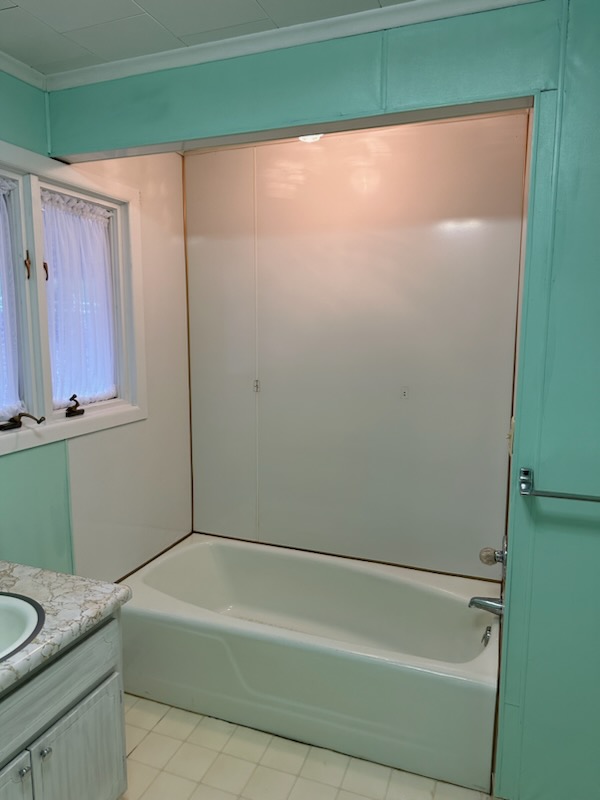

The cheapest way to replace a bathtub with a shower is to choose the most basic options. Prefabricated shower kits fit the bill. They include a shower pan, surround, and fixtures. Some homeowners buy these kits and do the replacement themselves.
DIY tub replacement projects can go downhill quickly if you discover any leaks or rotting flooring under the old tub. It’s one of the many reasons why calling in a bathroom remodeling specialist is one of the cheapest ways to replace your old tub with a new shower.
Bathroom conversion installers can implement other cost-saving measures while replacing your tub. They can keep existing plumbing in place and ensure that your new shower meets all your needs, so you don’t have to do more renovations in the immediate future.
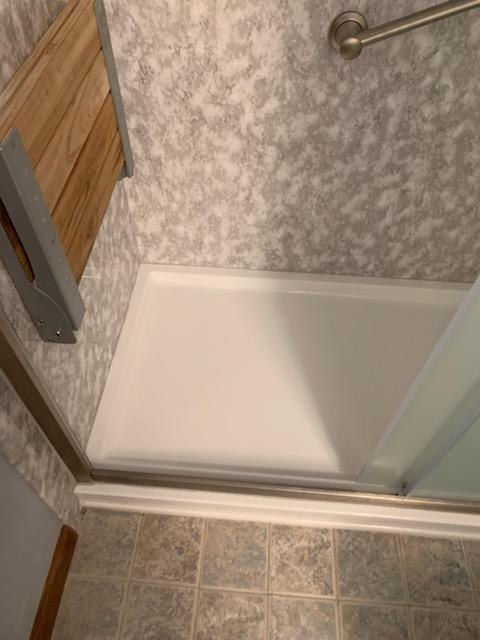
Bathroom conversions are one of the most effective ways to improve accessibility in your bathroom. There are several ways beyond switching out your tub to a walk-in shower to make your bathroom easier for everyone to use.
Other modifications that boost accessibility and functionality include:
Other accessibility features are available, so be sure to discuss all your needs with your bathroom remodeling contractor before work begins.
Converting a tub to a shower can have positive and negative effects on home value depending on several factors. If the tub you plan to convert is the only bathtub in the home, couples with children may shy away from buying your home in the future because they often prefer homes with at least one bathtub.
To minimize the risk of a negative impact on your home value, it’s important to work with a professional contractor who has experience in bathroom conversions and can help you make informed decisions about the design and features. Choose shower options that can compete with bathtubs to get the most return on the investment.
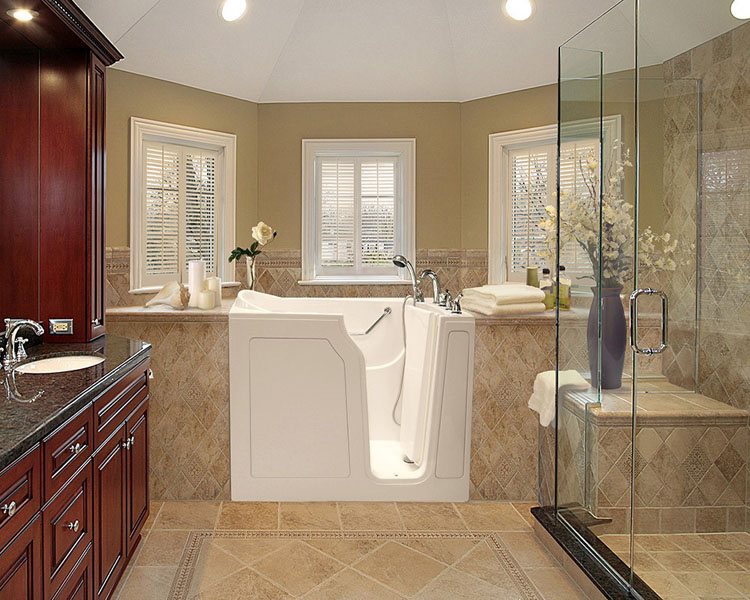
Yes, it’s possible to convert a shower into a walk-in tub. Most walk-in tubs are smaller than traditional showers, so they can easily fit into smaller spaces.
Traditional showers measure 60 inches long. In comparison, walk-in tubs are approximately 52 inches long. Installers can turn and rotate walk-in tubs to fit into smaller spaces that previously held showers if necessary.
It’s important to consult a skilled walk-in tub installer if this is a consideration for your bathroom remodeling project. They can ensure the work is done safely and within your budget.
The cost to convert a shower to a walk-in tub varies depending on several factors. The size and style of the walk-in tub, the extent of any necessary plumbing and electrical work needed to accommodate the tub, and any additional features you choose all affect the final price.
Factors that have the most influence on the cost of converting a shower to a walk-in tub include:
Make sure you’ve reviewed your budget with your bathroom installer so you can work together to choose options that don’t exceed what you can afford.
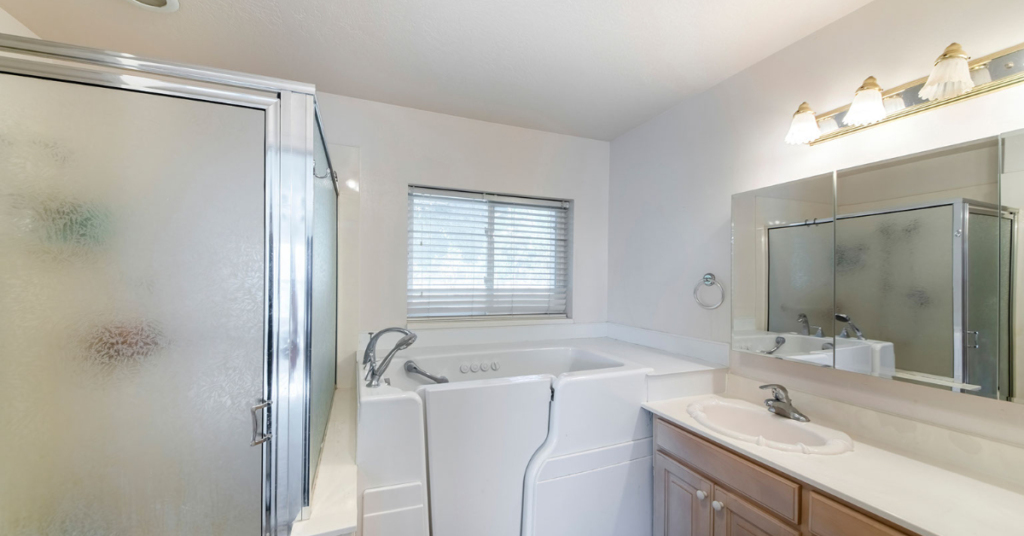
Walk-in tubs aren’t for everyone. There are advantages and disadvantages to having one installed. Consider whether the benefits outweigh the risks before starting this kind of bathroom conversion project.
Walk-in tubs are available in a variety of sizes. Some models fit into the same space as a traditional bathtub. Others may require modification to the bathroom space to fit properly.
Accessibility and size play a role in whether a walk-in tub fits into a regular tub space in your bathroom. Some walk-in tubs have a wider or longer profile, which might require additional bathroom remodeling to ensure the tub fits and is accessible.
When considering a walk-in tub, it’s important to get accurate measurements. That’s why Just Bath doesn’t include walk-in tubs in our instant quote option. We want to ensure your new walk-in tub fits in your bathroom before we schedule installation.
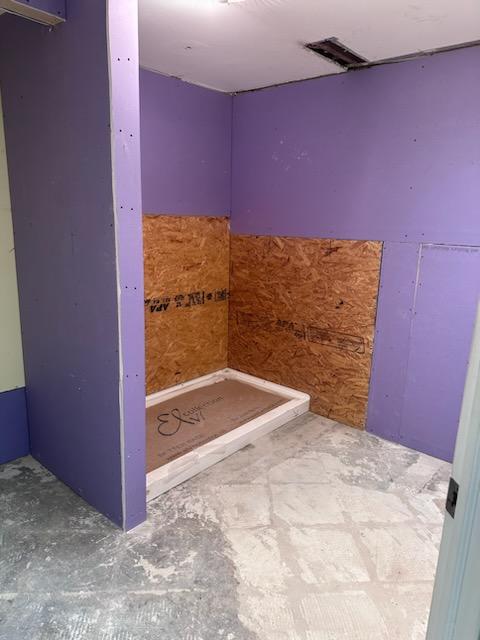
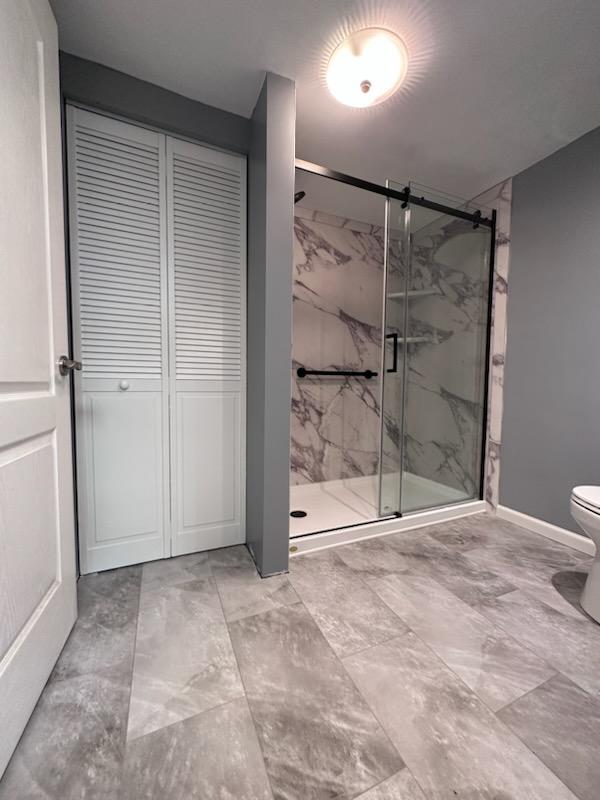
The length of time it takes to convert a bathroom depends on the scope of the project, the size of the bathroom, and other factors.
Some bathroom conversions – like replacing a tub with a shower – take about 48 hours to complete. More extensive projects that include a full bathroom remodel can take several weeks to finish.
The timeline for a bathroom conversion is broken down into several stages:
The timeline for each of these stages varies depending on the scope of your project. Just Bath always provides an estimated completion date before work begins.
Bathroom conversions don’t have to be complicated when you work with the right installer. Just Bath’s step-by-step process ensures you’re the focal point for all bathroom remodeling projects.
Our team lets you know what to expect from day one with us, and we never pressure you to agree to a bath conversion plan that doesn’t 100% satisfy your needs.
All our projects come with lifetime warranties and financing options. Give us a call today at 724-400-2284 to schedule your free, no-obligation consultation.
Bathroom conversion projects add value to your home while improving your quality of life. Something most homeowners may not consider is the waste and pollution they create during a bathroom renovation.
The good news is you don’t have to live with that outdated bathroom or unsafe conditions like bathtubs that are too high to get in and out of safely. You can take several steps to ensure your project is environmentally friendly from start to finish.
In this blog, we’ll discuss 5 brilliant ways to green up your bathroom conversion project for a win-win situation for you and the environment.
You might think that the demolition of the old space is the first critical step in your new bathroom renovation. As fun as it may be to swing a sledgehammer around in your bathroom, it shouldn’t be done without first planning ahead.
Before you start demolition, plan out your renovation project from start to finish. Not only does it help you avoid costly mistakes, but it also gives you an opportunity to consider the environmental impact of your choices.
Here are 3 tips for planning ahead with your bathroom conversion project to keep it as eco-conscious as possible:
1 – Explore different materials, fixtures, and designs.
Sustainable materials like bamboo and cork, plus water-saving fixtures, can be part of the process. Choosing the wrong fixtures, for example, can create more harm to the environment if you end up replacing them sooner than expected.
2 – Set a budget.
Once you know how much you can afford, your budget can guide decisions about sustainable materials and other eco-friendly methods for your bathroom conversion project.
3 – Hire a professional.
Working with a bathroom conversion specialist ensures you stick to your plan. They can help you find the most eco-friendly solutions within your budget and ensure your new bathroom lasts for years to come to reduce your environmental footprint.
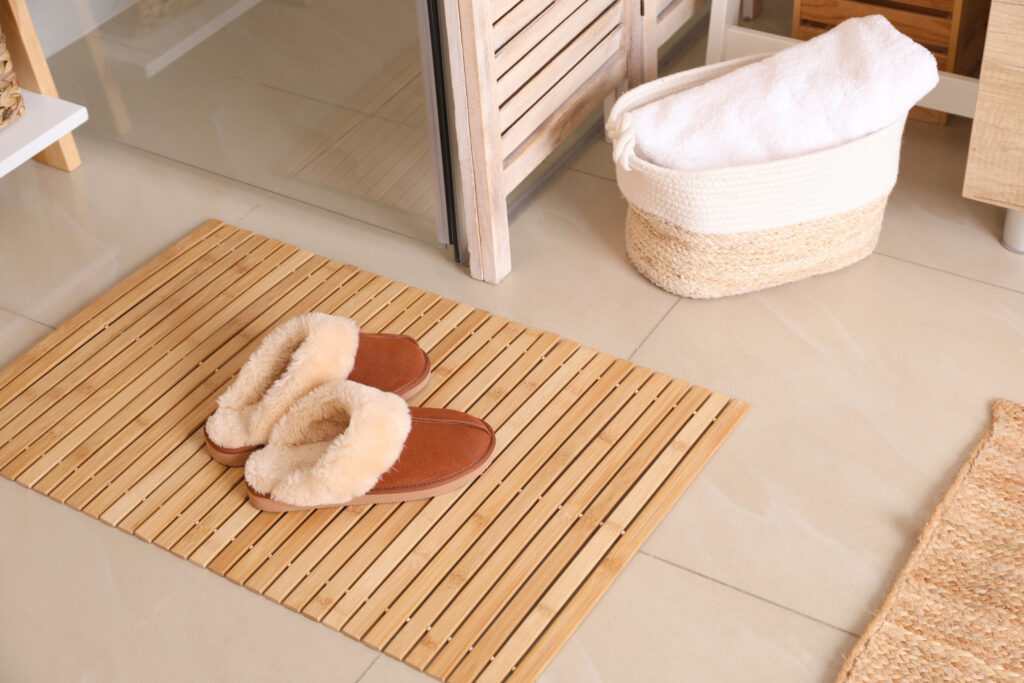
Sustainable materials – bamboo, cork, recycled glass – can fit well into any bathroom renovation project. Not only are these materials good for the environment, but they also add a touch of luxury to your bathroom.
If you’re not sure which sustainable materials you can afford or which are available to you, check with your bathroom renovation contractor. They can recommend specific products and materials that fit within your budget.
Don’t forget to check with your local government about incentives for using sustainable materials in home renovation projects. You can choose resources that match programs in your area.
During demolition, consider which materials to recycle or reuse to reduce the amount of waste going to the landfill. It’s easier to reuse some items in your bathroom than others. Here are some tips for identifying what’s reusable and what’s not.
If you don’t want to keep any of your items, consider donating them to a place like Construction Junction. Another option is to donate them to a local Habitat for Humanity ReStore.
Can’t recycle or reuse your materials? Make sure you dispose of them properly. Most communities have programs that accept construction and demolition debris.
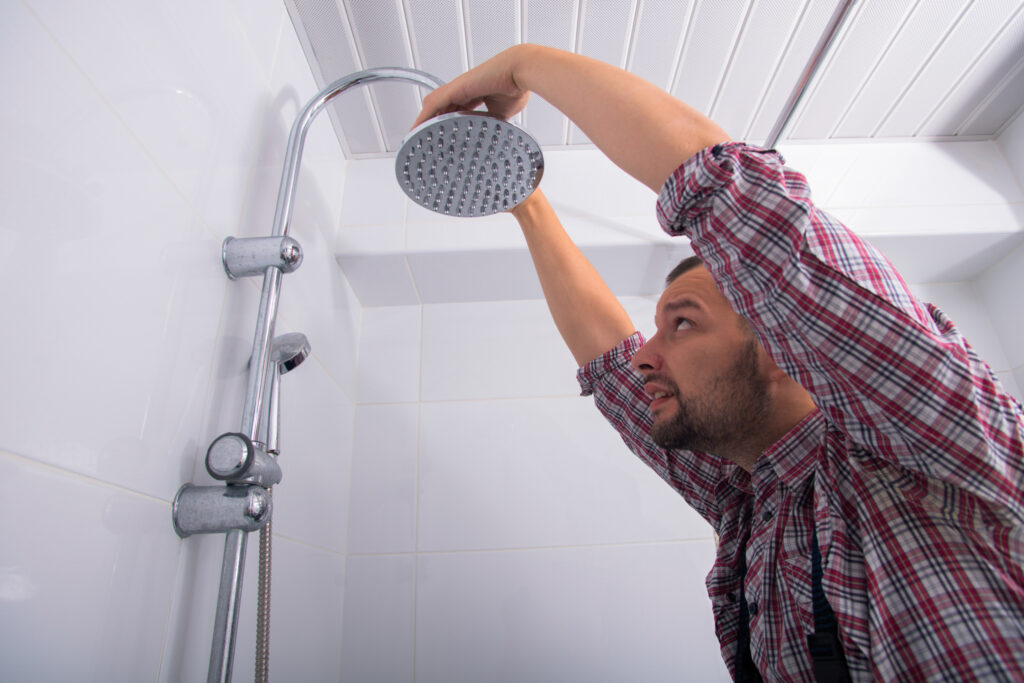
One of the most effective ways to make your new bathroom environmentally friendly is with water-saving fixtures. Low-flow toilets, faucets, and showerheads save you money by using less water.
Fresh water makes up less than 3% of the available water sources on the planet. Water conservation is important for this and other reasons.
Water-saving fixtures also reduce the amount of energy needed to treat and distribute water. The less water you use, the more you can reduce greenhouse gas emissions and protect the environment.
Going green with your bathroom conversion project doesn’t just mean installing water-saving fixtures and choosing sustainable materials. You can keep the eco-friendly cycle going by committing to using natural cleaning products to keep your new bathroom looking clean and fresh.
You can buy popular eco-friendly cleaning products at your favorite store, or you can make your own solutions at home. Here are some of the most popular ingredients if you decide to make them from scratch.
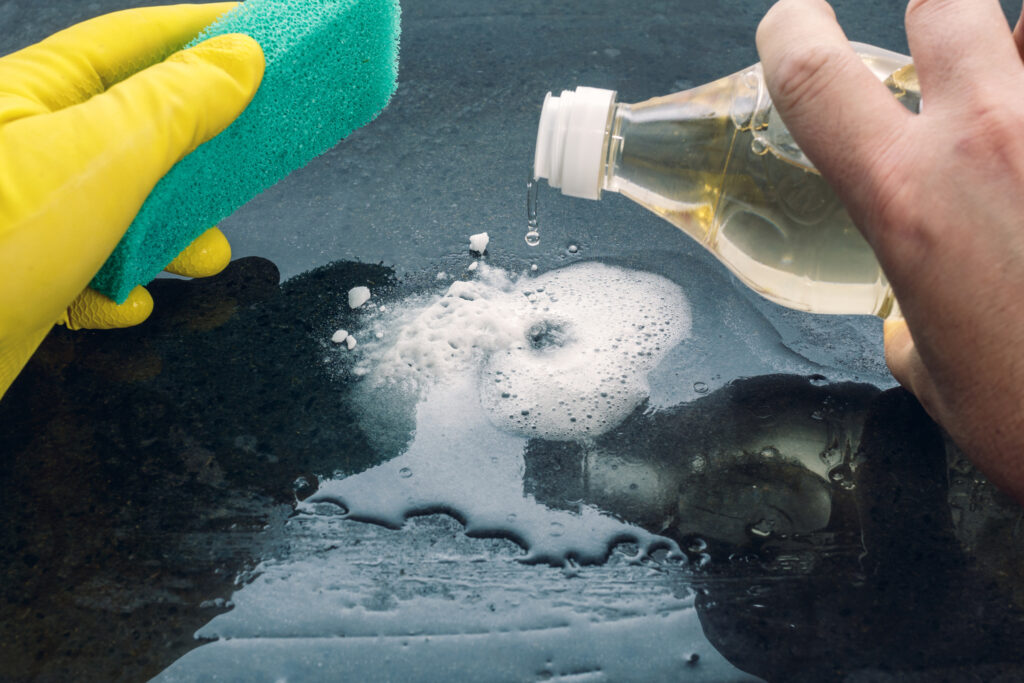
Improving the functionality of your bathroom with environmentally-friendly practices in mind requires cooperation from a bathroom conversion specialist. Just Bath’s installation experts ensure you not only save yourself money but that you also do your part to save the planet.
Give us a call today to schedule a consultation, or use our instant quote feature on our website to get started.
The average person spends 30 minutes a day in their bathroom. That’s roughly 182 hours a year consumed by brushing your teeth, taking a shower, or using the toilet.
Make the most of your time with a bathroom conversion project that transforms this necessary room into a place that is beautiful and functional.
Even small bathroom remodeling projects can bring new life to outdated, inefficient, and uncomfortable spaces.
Whether you want to increase your home’s value to put it on the market or create a more inviting space for your personal enjoyment, a bathroom conversion project is a smart investment.
In this blog, we’ll discuss the 5 most popular reasons homeowners redo their bathrooms:
One of the most common reasons to consider a bathroom conversion project is to improve the functionality of the space. Maybe you need more storage for towels and other bathroom necessities. Perhaps your fixtures are outdated, or you need to reconfigure the layout to better suit your needs.
Bring new life to your space by including one of the following fixes guaranteed to improve functionality:

Bathroom and kitchen renovations are among the home improvement projects that offer the biggest return on investment. According to a 2022 Cost vs. Value Report, you can recover up to 58% of the cost of a bathroom remodel when you sell your home.
Making your bathroom more accessible allows you to sell to a larger demographic in the future. If you take it one step further by turning it into a “smart” bathroom, you can boost the ROI even further. Some of the most popular bathroom technology includes:
Outdated bathrooms don’t just look unappealing. They waste energy. If you’ve decided to upgrade your bathroom, it’s worth exploring the following ways to improve your energy efficiency.
Installing low-flow fixtures is one of the easiest ways to save water and energy. Faucets, showerheads, and toilets can be upgraded to use less water than their standard counterparts.
Upgrading to LED lighting is another way to update your lighting while improving energy efficiency. Residential LEDs use at least 75% less energy and last up to 25 times longer than incandescent lighting.
Talk with your bathroom conversion specialist to discover other ways to boost energy efficiency in your new bathroom.

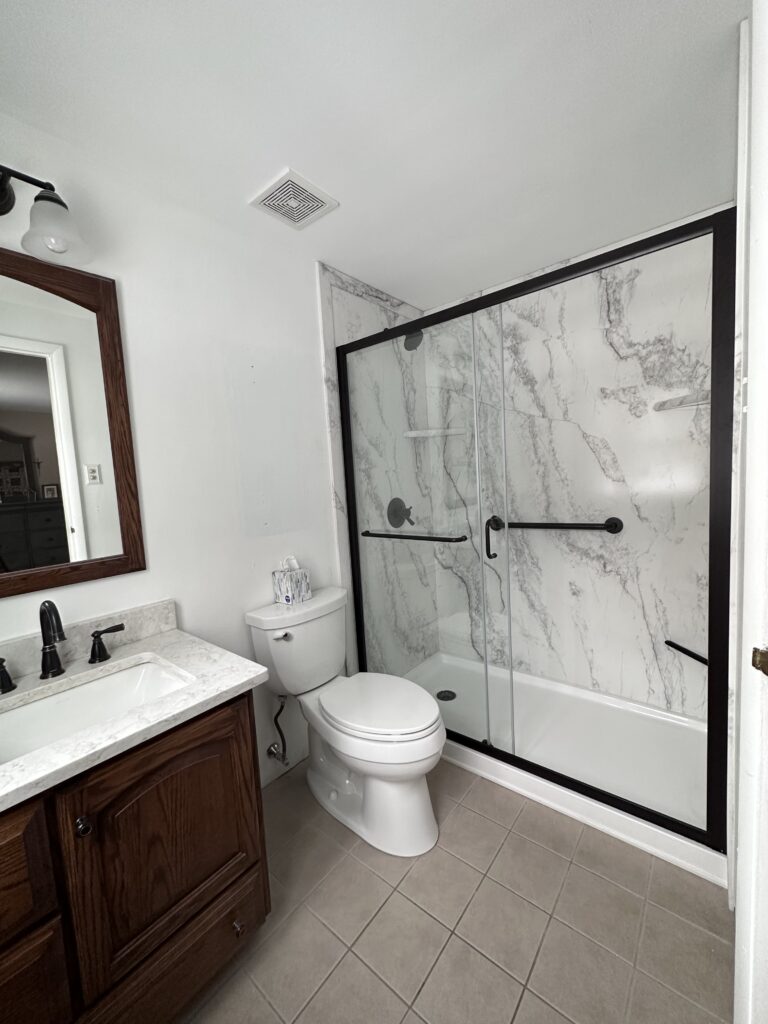
There’s a lot you can do to improve the look of your bathroom besides a tub-to-shower conversion or replacing your standard bathtub with a walk-in tub for improved accessibility. Updating your color scheme, adding some modern features, and incorporating natural materials create a more inviting and luxurious space.
Here are 2 easy fixes to improve the look of your bathroom:
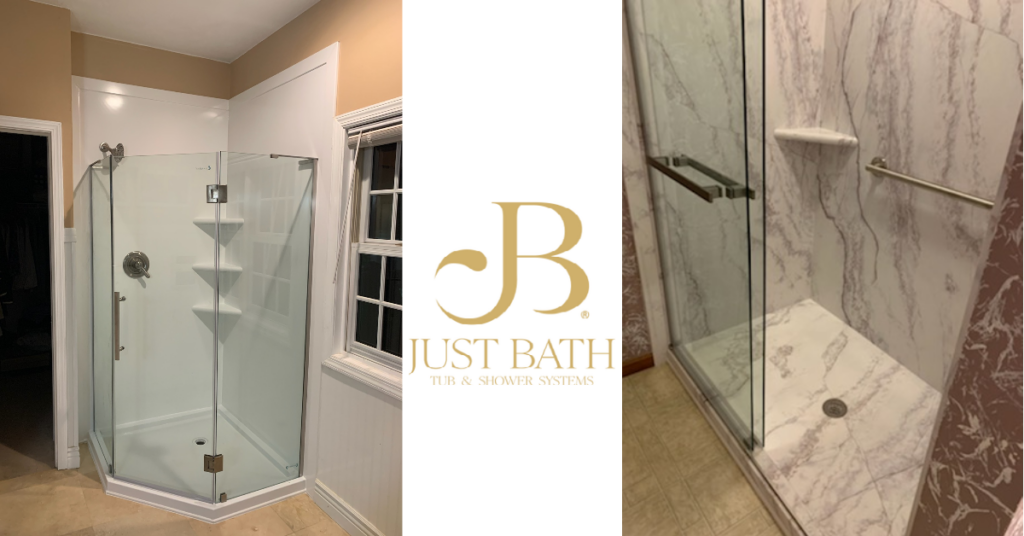
Depending on the type of bathroom conversion project you choose, you can increase your comfort in several ways.
Adding square footage or reconfiguring the layout of your bathroom cures a cramped space problem. Converting a bathtub to a walk-in shower is ideal for older adults or individuals with mobility issues by making it easier and safer to get in and out.
If you want your bathroom to feel more like a spa, consider including features like a soaking tub or a towel warmer. The possibilities are truly endless.
Start enjoying your bathroom today when you schedule a bathroom conversion project with Just Bath. We can help you achieve your goals for your new bathroom at reasonable prices. Give us a call today to get on our schedule.
Bathroom conversions accomplish many goals. Most homeowners wish to replace outdated tubs with state-of-the-art showers that are easier to maintain. But there’s another reason to consider working with a bathroom conversion specialist near you: accessibility.
As we age, our mobility and ability to perform everyday tasks become more challenging. Designing homes with accessibility in mind is important if we want to age in place.
Bathrooms are one of the most critical spaces in a home for accessibility because they’re such an integral part of our daily routines. A bathroom conversion project that prioritizes accessibility helps aging homeowners or those living with disabilities maintain their independence.
In this article we’ll discuss:
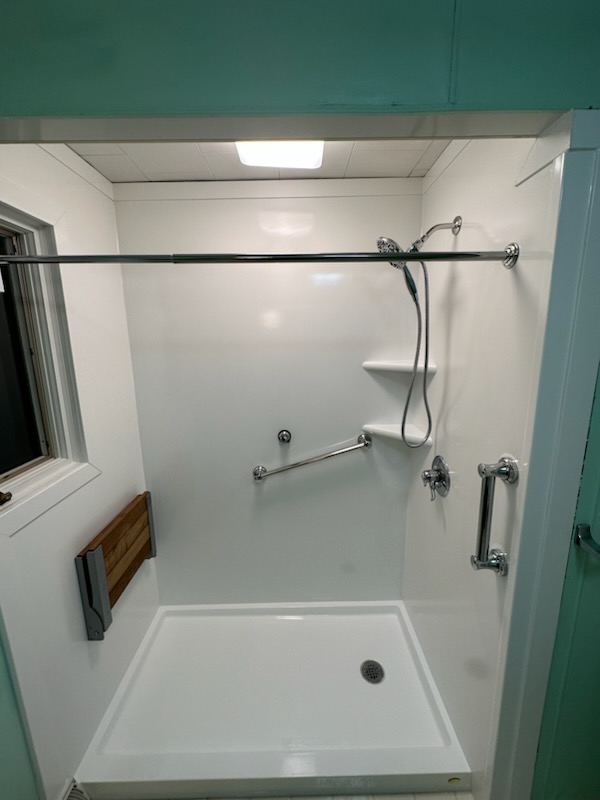
An accessible bathroom is designed to be used by people with disabilities or who have limited mobility. Providing a safe and functional space for people of all abilities to use independently is the main goal of an accessible bathroom.
Bathroom conversion projects that aim to improve accessibility have the following features:
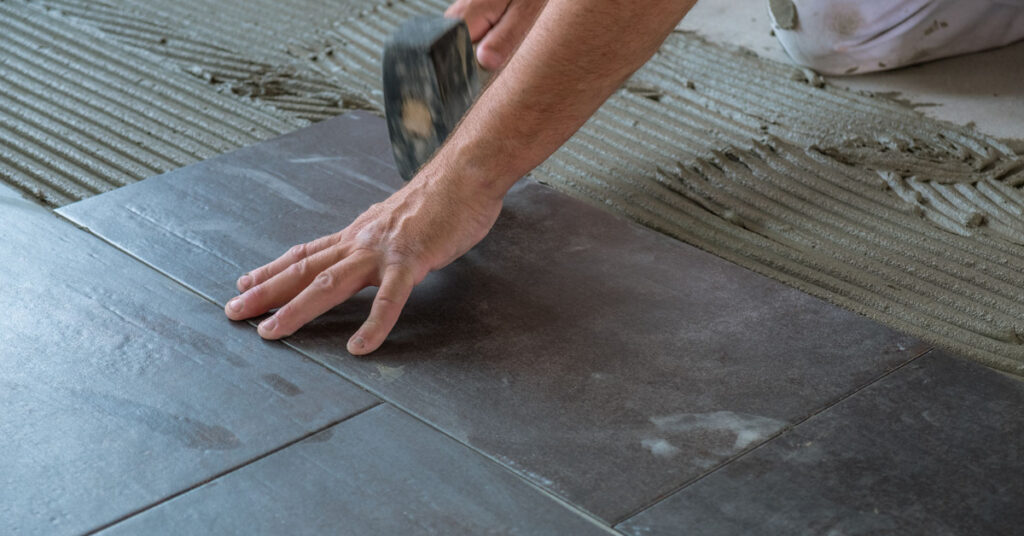
Accessible bathrooms improve safety by removing one of the most common hazards in a bathroom: slippery flooring. Designing a bathroom with accessibility in mind means reducing the risk of accidents by using non-slip flooring.
Several options exist for non-slip flooring. Some of the most popular include:
Talk with your bathroom conversion specialist to identify the best flooring solution for your accessible bathroom before getting started.
Living independently is important for many adults, including those who are aging in place or have disabilities that impact their daily lives. The ability to use the toilet or shower without assistance is an important part of feeling independent.
Accessible bathrooms improve quality of life and help disabled adults live with dignity.
Some of the most common features to consider for boosting your independence with a bathroom conversion project include grab bars, higher toilet seats, and walk-in showers or walk-in bathtubs.
An accessible bathroom conversion does more than make it easier for people with disabilities or limited mobility to live independently. It improves the functionality of the entire space.
One of the key features prospective homebuyers seek in bathrooms that are aesthetically pleasing and functional. Bathroom remodeling projects offer the biggest return on investment, so it’s worth your time and money to advance the functionality of yours by making it more accessible.
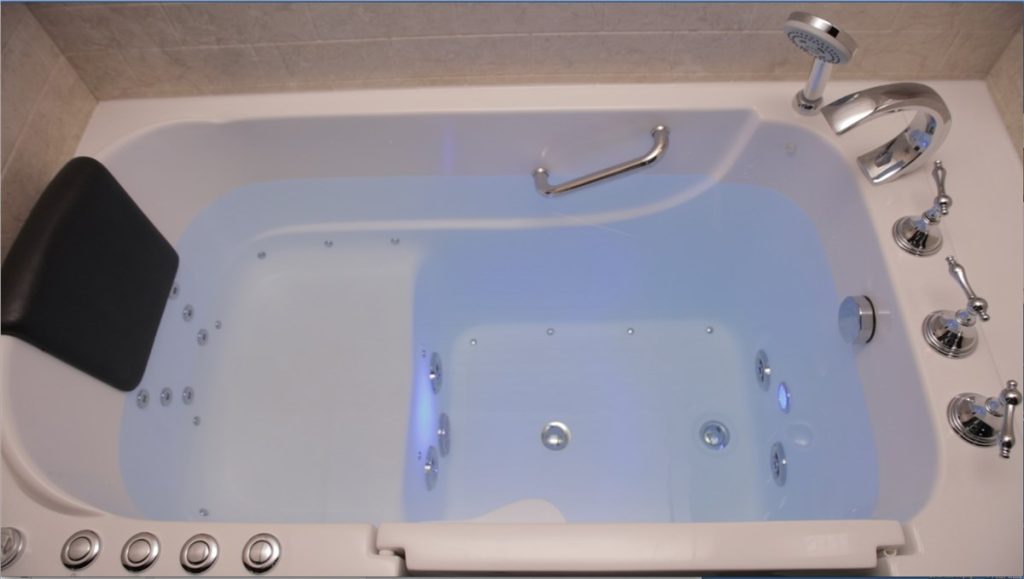
Bathroom conversions future-proof your home, ensuring you can age in place. You won’t have to worry about making significant changes to your home to accommodate your needs. An accessible bathroom conversion project creates a bathroom space that’s suited to your current and future needs.
Work with your bathroom conversion specialist to decide on the features you want most in your accessible bathroom. Some of the ways you can identify which aspects to include:
An accessible bathroom conversion is essential for anyone who wants to maintain their independence and boost their home’s resale value.
Work with a bathroom conversion company that understands how to create a space that is functional, future-proofed, and safe for people of all abilities.
Choosing between acrylic and fiberglass shower bases is one of the many decisions homeowners must make when updating their bathrooms. Make the wrong choice, and it can impact your return on the investment (ROI).
Bathroom remodels, when done the right way, yield the biggest returns by boosting your home’s resale value. Simple cosmetic changes produce a $1.71 increase in home value for every dollar spent. Big-ticket items like bathtub-to-shower conversions and luxury bathroom installations push the ROI even higher.
To help homeowners make the right decisions, this blog explores:
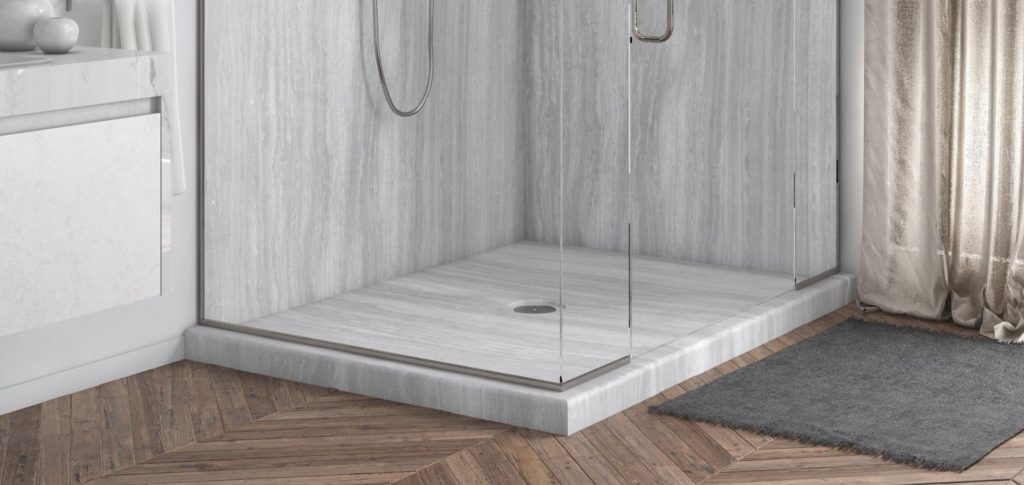
Shower bases, sometimes called shower pans, are the pre-formed trays that make up the bottom of a shower enclosure. They’re designed to catch and drain the water from your shower so it doesn’t end up on your bathroom floor.
A secondary purpose of shower bases is to serve as the foundation for your shower walls. They can be made from acrylic, fiberglass, or porcelain. Without the right shower base, you can experience improper drainage and water leakage issues.
Shower bases come in different sizes to accommodate your bathroom renovation project. Traditional shower bases consist of a 30-inch by 30-inch square. Neo-angle pans for corner showers are triangular-shaped.
Customers who choose bathtub-to-shower conversions may have longer, rectangular shower bases if they wish to keep the size of their new shower consistent with that of the previous bathtub.
Your bathroom remodeling contractors can help you choose the best fit for your bathroom space.
Acrylic and fiberglass shower pans are the most popular choices among homeowners updating their bathrooms. Which one you choose depends on your budget and personal preferences. Most homeowners decide based on cost differences, customization options, and durability factors.
Affordability plays a big part in whether customers choose acrylic over fiberglass shower bases. Knowing the cost before installation is a priority for most homeowners when upgrading their bathrooms.
While both are among the most affordable options for bathroom remodeling projects, acrylic shower pans cost slightly more than their fiberglass counterparts. However, the caveat of getting what you pay for holds true with acrylic vs. fiberglass shower bases.
We’ll explore further why acrylic is the smarter choice in the customization and durability sections.
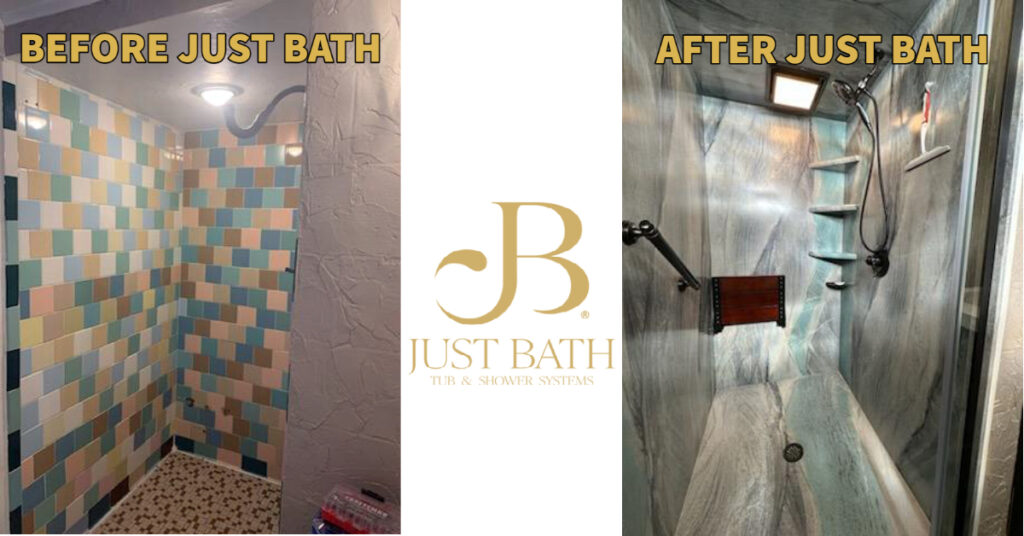
If customization is important for your bathroom remodeling project, then acrylic shower bases are the best option. Acrylic is a more durable material, but it also has greater flexibility than fiberglass. You can mold it into a variety of shapes and sizes to suit your bathroom conversion goals.
Besides the ability to manipulate their size and shape, acrylic shower pans come in several colors and finishes to further enhance your customization options.
Fiberglass shower base manufacturers provide some options for colors and finishes, but not to the extent you can get with acrylic.
Acrylic shower pans are made of solid surface material reinforced with fiberglass. Alternatively, fiberglass shower pans consist of layers of 100% fiberglass material. Their construction influences their durability factor.
Acrylic generally is considered more durable than fiberglass because of its solid surface. It’s more resistant to impact and cracking because of the added strength. Acrylic also is less porous than fiberglass, so it’s less likely to absorb liquids that can cause discoloration, staining, and eventual deterioration of the material.
If you’re going to spend money on bathroom updates, make sure they last to get the most return on your investment.
Beyond the differences in cost, customization, and durability, there are other benefits to acrylic shower pans that you can’t get with fiberglass. One such perk of acrylic is it provides seamless shower connections and wainscotting.
“It has a natural beauty and a clean and polished look,” said Art Kivivali, owner of Just Bath. “Plus, it doesn’t add too much weight to the shower system, so it won’t damage your subflooring or foundation.”
The acrylic shower bases Just Bath uses in all its bathroom conversion projects are made from natural stone with 8,000 pixels of laminate printed on them to create unique designs for customization.
Beyond their flexibility for customization, acrylic shower pans are low-maintenance and easy to keep clean. Unlike some other materials, acrylic doesn’t require frequent grout cleaning or resealing. You can simply wipe it down with a mild cleanser and soft cloth to keep it looking new.
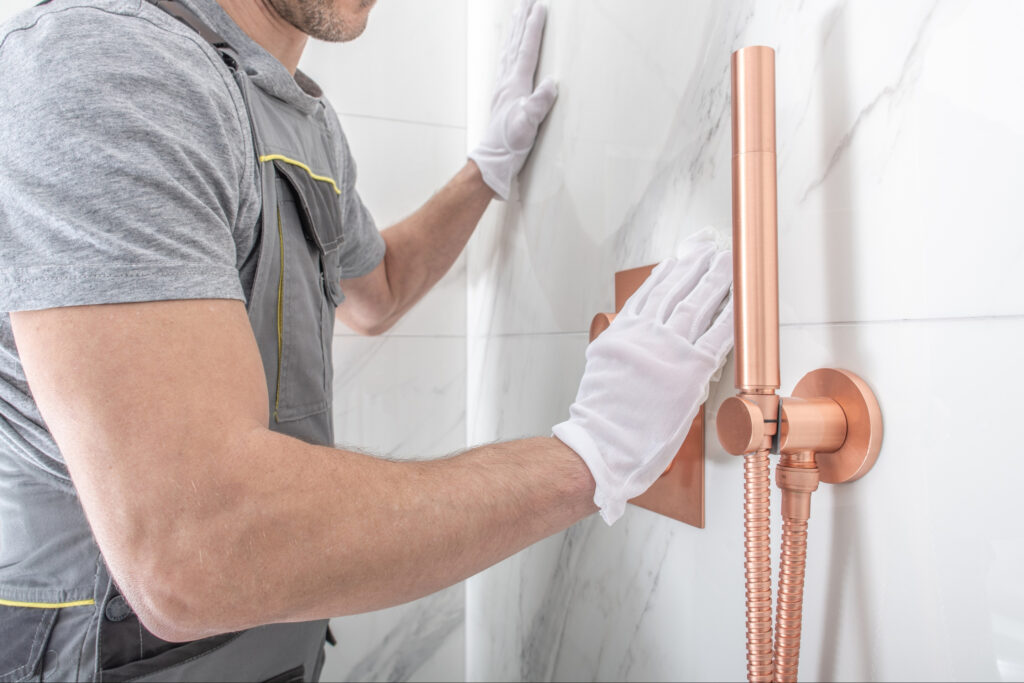
Acrylic shower pans are lightweight, which makes them easy to install. Some of the things that can affect installation time include the shape and size of the shower base and the skill level of the installer.
Most bathroom renovation projects—including bathtub-to-shower conversions—take about a day to complete. The installation process includes several steps:
Depending on the scope of your project, a plumber may need to adjust the drains and plumbing or cut the shower base to fit specific dimensions.
Make sure you work with a professional installer that can provide a cost and time estimate for your shower base installation for the best experience.
Just Bath has more than 30 years of combined experience on its installation team. We use our industry expertise for luxury bath remodeling, bathtub-to-shower conversions, and other bathroom-in-one-day projects.
Have additional questions about acrylic vs. fiberglass shower bases? Give us a call today at 724-400-2284. We’re happy to assist!
Cleaning your bathroom isn’t high on most people’s priority lists. No one likes spending valuable time cleaning their house when they could be doing something fun instead. It seems like even more of a punishment when the cleaning chore involves the bathroom. After all, it’s the one room in your house where you’re most likely to find grime, mold, and other gross residue lurking.
Sure, you could hire a cleaning company to do the dirty work of cleaning your bathroom. Or you could suck it up and try these useful tips for cleaning your entire bathroom that make the task less torturous.
In this blog, we’ll discuss:
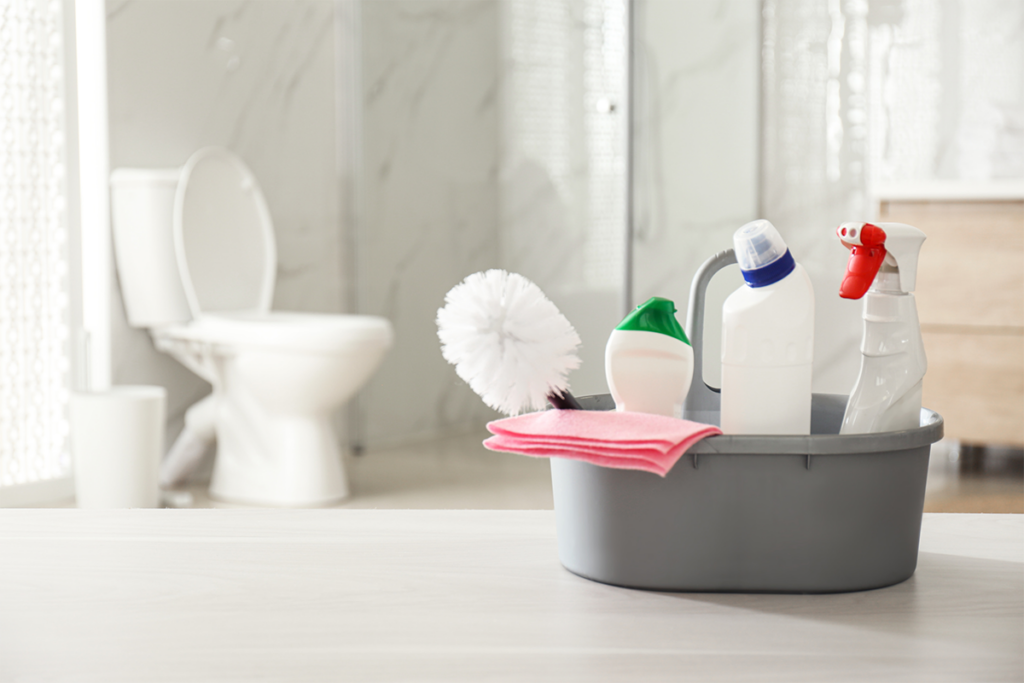
Gathering the supplies that you need for cleaning your bathroom can feel more like preparing to enter a toxic landfill. You strap on your rubber gloves and charge into the room armed with a well-stocked supply of disinfecting chemicals to battle an army of germs that await.
What should you include in your cleaning supply kit? Here are a few of the tried-and-true products you may want to consider.
Bathrooms come with plenty of hard surfaces like counters, sinks, and toilets. Choose one of your favorite all-purpose bathroom cleaners and put it in a handy spray bottle for use on these areas. Just spray it on, wipe it down, and voila! The area is clean and germ-free.
Disinfectant wipes should be part of every bathroom cleaning kit. They are useful for quick wipe downs of surface areas and door handles to prevent the spread of germs. Use them daily between regular bathroom cleanings to keep surfaces sanitized.
If your bathroom mirror looks anything like ours, you probably find toothpaste spittle and water splashes from the sink on it regularly. A glass cleaner is a must for keeping your mirrors sparkling clean. Use only a small amount of glass cleaner and a paper towel for streak-free results.
Grout can get gross looking fast. A heavy-duty grout and tile cleaner, coupled with a grout brush, can keep it looking fresh and new without too much effort on your part. While you don’t need to scrub your grout every time you clean the bathroom, doing so twice a year is recommended for the best results. The rest of the time, just spray the tile with an all-purpose cleaner or one made specifically for bathroom tile, and then wipe it down.
Bathroom floors are notorious for harboring some serious debris, including shedding hair and toenail clippings that missed the trash bin. Some vacuums work well on tile flooring in the bathrooms. You can use them weekly to remove the surface dirt from your bathroom floor.
At least once monthly, give your bathroom floors a thorough mopping. If you have several people sharing a bathroom, you may need to scrub the floors more frequently.
Most people use harsh chemical products to clean their bathrooms. Protect your skin from the damaging effects of repeated exposure to these toxins by wearing rubber gloves every time you scrub down the bathroom.
It’s also not a bad idea to open a window while cleaning with these products to protect your lungs from inhaling the fumes they produce.
Cleaning the toilet is perhaps the least desirable chore. Nevertheless, it must be done if you want to prevent the spread of nasty germs. Use a high-quality toilet bowl cleaner and a sturdy toilet brush to remove grime from the inside of the bowl.
Toilet bowls can smell gross, even after cleaning. Consider using a toilet bowl deodorizer if you find this is a problem in your bathroom.
Don’t forget to occasionally clean the toilet bowl brush. Use a disinfectant like bleach on it, rinse it clean, then allow it to dry before putting it back in the holder.
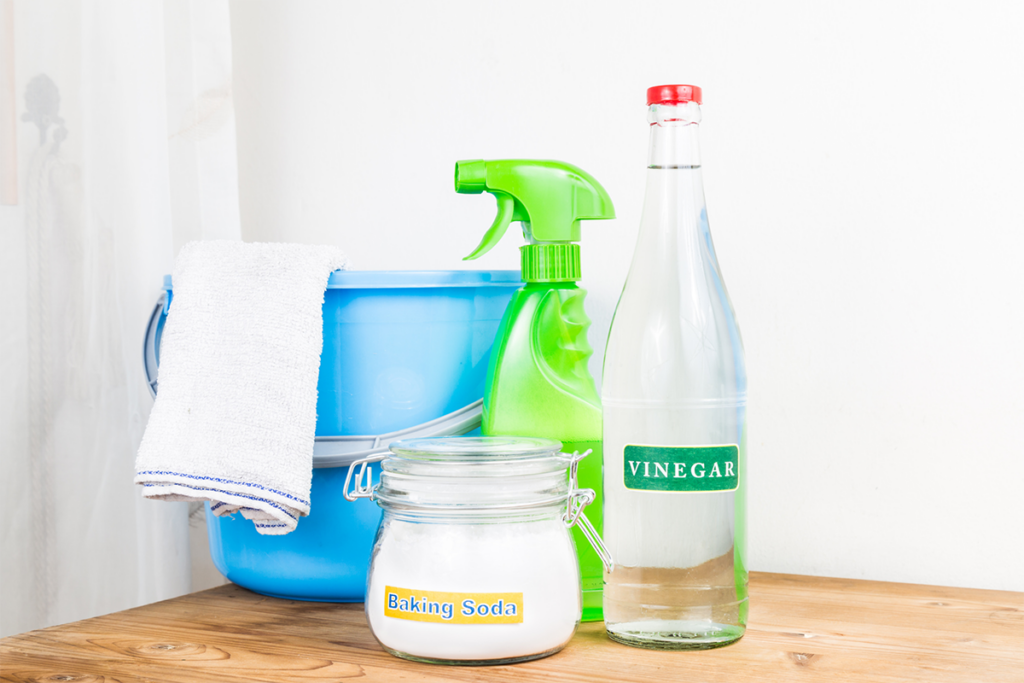
Some people prefer not to use harsh chemicals in their homes for many reasons. The good news is you don’t have to rely on commercial cleaners. You can make natural, eco-friendly solutions that work just as well for cleaning and preventing the spread of germs.
An effective replacement for commercial surface cleaners requires 2 cups of baking soda, ½ cup of all-natural dish soap, ½ cup of vinegar, and 1 cup of water. Mix thoroughly and pour into a spray bottle. It works on soap scum and other grime that sticks to hard surfaces in your bathroom.
To clean floors, mix ½ cup of baking soda and ¼ cup of lemon juice into a bucket of warm water. If you want a scented all-natural floor cleaner, consider adding a few drops of essential oil to the mix.
Vinegar is another all-natural solution you can use for mold and mildew buildup in showers, tubs, and other tiled surfaces in your bathroom. Spray it on, let it dry, spray again, then wipe it down for the best results.
Dealing with some particularly tough soap scum that’s not responding to vinegar or baking soda? Take half a grapefruit and pour some salt on top. Then, rub the grapefruit on the soap scum.
Cleaning your bathroom daily is probably not necessary. Yes, germs, mildew, mold, and other scum can build up quickly in a bathroom. That doesn’t mean you need to obsess about their cleanliness.
Bathrooms may be gross, but that doesn’t mean you need to give them a full cleaning every day. Wiping hard surfaces down with sanitizing wipes can keep your bathroom relatively germ-free in between more intensive cleanings.
As a rule, you should give your bathroom a good scrubbing down at least once a week. That includes wiping down the toilet and sink, plus cleaning the shower or bathtub.
If bathtubs and showers become overrun with mildew and other surface slimes you can’t seem to scrub away, it may be time to consider a bathroom conversion project.
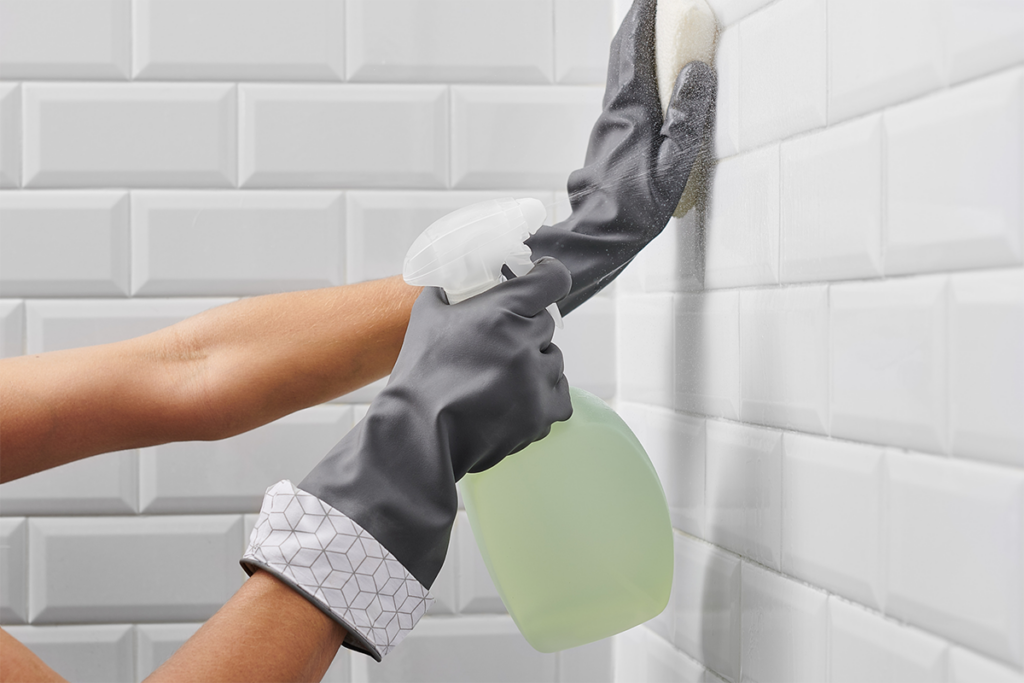
One of the biggest mistakes you can make when cleaning your bathroom is mixing cleaning products. Not only can this ruin delicate surfaces like marble, but it also can cause you serious harm if you inhale certain mixtures.
An important rule of thumb is to never combine ammonia and bleach. Each has its place in cleaning, but when you combine them, it creates a toxic gas that can singe your lungs and even cause death. The same guidance applies to bleach and vinegar.
Another common error people make when cleaning the bathroom is to use the same sponge for every surface. Doing so risks transferring germs from one area of the bathroom to another. Use a separate sponge or cleaning cloth for every surface.
Trust us when we say you don’t really need a shower door. Who has time to remove the streaks (not to mention the hard water and soap scum stains)? Doorless showers for your bathroom conversion are a much better option.
Glass shower doors require constant cleaning to look their best. If you don’t use the right tools and cleaners for the job, you can end up with a mess that makes your bathroom look outdated and unclean.
If your glass shower doors are looking less than lustrous these days, you could spend time researching the most effective ways to keep them sparkling like new. Or you could schedule a consultation for a bathroom conversion project that replaces outdated glass doors with a better alternative.
In this blog we’ll discuss:
Doorless showers are a great alternative to traditional showers with glass doors. Sometimes called walk-in showers, they are designed in such a way that you can keep water off your floors without using a door or curtains.
Another important distinction is that doorless showers only contain a walk-in shower. They can’t be used as a bathtub-shower combination.
Doorless showers first emerged in the U.S. in the 1980s but were limited to high-end homes. Today, anyone doing a bathroom conversion or remodeling project can request a doorless shower.
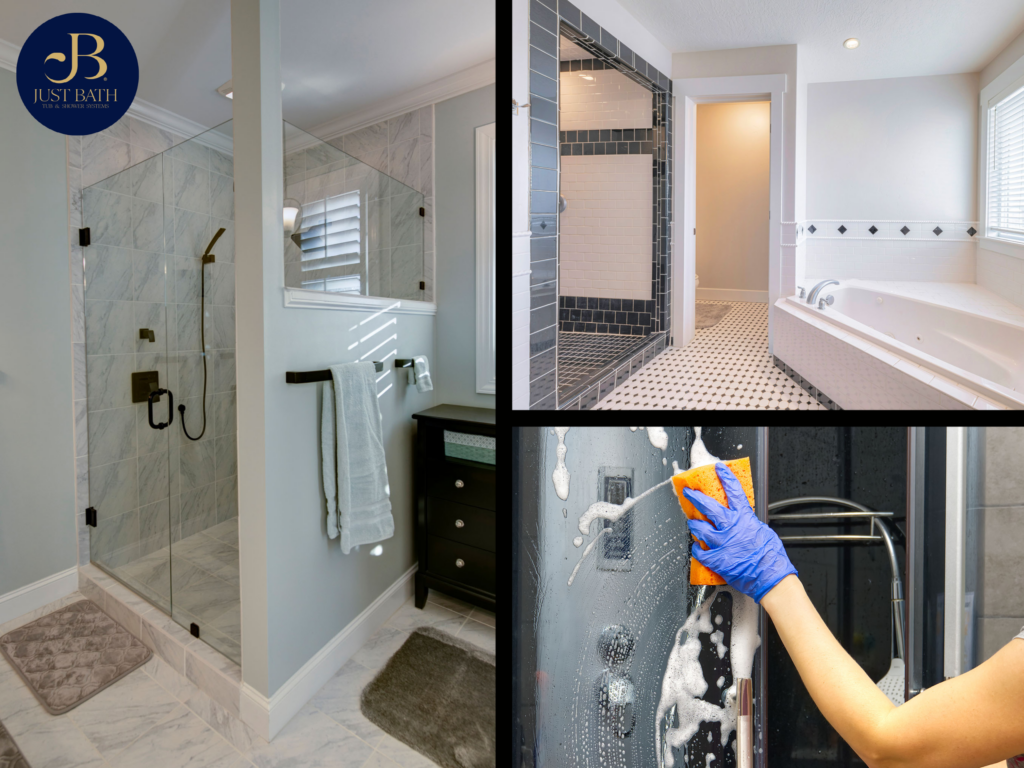
It’s not difficult to spot the benefits of doorless showers. One of the biggest advantages is easier maintenance. Gone are the days of scrubbing your glass doors several times a week. As a bonus, without glass doors in the way, you can get a deeper clean for the shower surround.
Some of the other pros include:
We’d be remiss if we didn’t mention the disadvantages of doorless showers (there are some). The biggest issue is the lack of privacy. Without a door, there’s not much of a barrier between you and anyone else who may wander into the bathroom.
Other cons include:
Yes and no. Installation of doorless showers tends to be cheaper. However, the product itself can be pricier than a traditional shower.
The reason doorless shower products cost more is that they require a specialty drain that prevents water from getting onto your bathroom floor. Normally, a shower door would prevent this. Without one, the design of the doorless shower must perform that duty.

Using a specialty drain is one way to keep water in a doorless shower. Another popular way to keep water in a doorless shower includes overlapping short walls at the shower’s entryway.
Using this design to prevent water from exiting the shower involves two short walls, one on each side of the shower. In addition to keeping the water in the doorless shower, it provides the added benefit of more privacy for the person using the shower. The only downside to this method is it requires ample space to accommodate the two walls.
Other ways to keep the water inside your doorless shower include:
Just Bath’s team of bath conversion specialists can install a doorless shower during your bathroom in one day project at your request.
Before installation, our team ensures your bathroom has adequate space to accommodate a doorless shower. If we find your bathroom is not suited to this kind of shower for your bathroom conversion, we can make other recommendations for bathroom remodeling strategies that work.
Request a free quote for your next bath conversion project on our website and receive 20% off with no payment or interest until 2023!
If you’re wondering how to make your bathroom safer, we have one word for you: prevention. Slips and falls getting in and out of the shower or tub are the most common way to get hurt. Accident-proofing your bathroom is an effective way to protect yourself, your family, and your guests.
You can minimize slips and falls and other bathroom hazards by following a few simple steps. Not only do these tips increase your safety, but they also boost your home’s value.
When you fill your bathtub with hot water and bubble bath, the last thing on your mind is a trip to the emergency room. Yet, that’s exactly what can happen if you’re not careful. What was meant to be a relaxing experience can turn into an accident requiring medical attention.
Slipping and falling are the number-one cause of residential bathroom accidents. Bathtubs are the perfect environment for slipping and falling because they’re a wet and slippery surface. Most tubs require you to step up and over to get in or out of them, which is an added hazard.
Slips and falls also can happen if you get your foot caught on a loose bathmat or extension cord, both of which are common in many bathrooms.
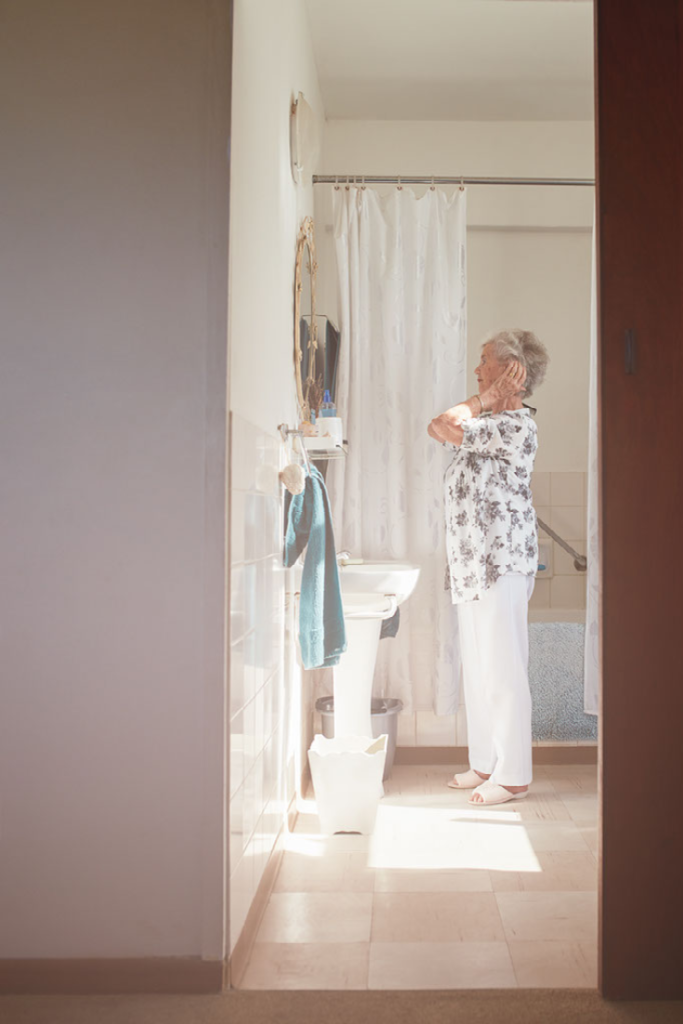
Absolutely. Age is one of the key risk factors for all types of falls, including those that happen in a bathroom. The U.S. Centers for Disease Control and Prevention (CDC) estimates that for every second in the day, an older adult suffers a fall. Several factors contribute to the increased danger.
Muscle loss begins around age 30. By the time you reach age 65, your muscle mass has decreased by about 12%. Combined with the weaker bones and decreased endurance that also come with age, falls become more likely. Lacking adequate strength means you also might have a more difficult time safely navigating in and out of the shower or tub.
Your vision worsens with age. It’s just a fact of life. Declining eyesight ups your chances of falling because you may not see obstacles in time to avoid them. Diminishing vision can be especially risky in a bathroom, where you may need to spot and avoid slick surfaces or judge how high to lift your leg before clearing the side of the tub.
You may not realize how much flexibility you need to get in and out of the tub until you’re no longer able to command your body to do what you want it to do. Health conditions like arthritis and some metabolic syndromes can reduce your dexterity, making it more difficult and even dangerous to bathe. When you’re less flexible, you’re more prone to falling.
Every year, more than a million Americans slip, trip, and fall in their bathrooms, according to the CDC. Don’t become a statistic in the next CDC report about bathroom safety. Use some of the following strategies to decrease your likelihood of suffering serious injuries.

Grab bars aren’t just for older people. They can come in handy for anyone who wants to safely maneuver in and out of a bathtub or shower. You can request a tub and shower conversion project that specifically includes grab bars in key areas to prevent slips and falls. Don’t forget about the toilet area. Grab bars are a safer way to get up and down for people with limited mobility.
Everyone likes their privacy. Locking the bathroom door might seem like a smart move to ensure you’re not disturbed while soaking in the tub. A locked bathroom door presents an obstacle if you should need assistance. Avoid the need to bust down the bathroom door by leaving it unlocked. Consider putting a “do not disturb” sign on the outside of the doorknob instead.
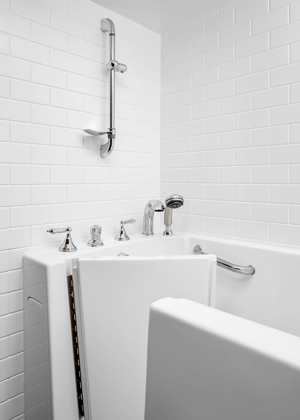
Walk-in bathtubs are an effective way of reducing slip and fall hazards in the bathroom. Standard bathtubs have high sides, which increases the risk of accidents for adults and children. Most walk-in tubs are fully customizable. You can request options like whirlpool jets and built-in seats for easier mobility once in the tub.
Even when you take all the necessary precautions, bathroom accidents can happen. Consider installing a life alert safety device or system in your home. If you do fall in your bathroom and are home alone, you can call for help using the device. Not all home medical alert devices work the same way. Make sure the one you choose has superior battery life and best-in-class fall detection technology.
Throw rugs may look nice in your bathroom but they are a major trip and fall hazard. Getting rid of them entirely is the most effective way to boost bathroom safety. If you just can’t live without them, then at least buy ones with non-slip backing so they don’t slide out from under you.

Avoid stumbles and falls by investing in some LED nightlights and other upgraded light fixtures for your bathroom. Nightlights can keep bathrooms well-lit for those middle-of-the-night bathroom visits. Lighting the hallways and other areas that lead to your bathroom adds an extra measure of security.
Just Bath has the installation experience and superior product availability to improve the safety of any Pittsburgh bathroom and beyond. From our high-quality walk-in tubs to our Just Safe safety alert devices, we give you confidence in the safety of your bathroom. Call today to schedule an in-person or virtual consultation with one of our bath conversion specialists. All virtual appointments receive a 20% discount on our services.
Bath conversions come out on top in the list of the 5 most common remodeling projects for homeowners. Surprised? For years, kitchens reigned supreme as the most popular room to renovate. Not anymore.
Bathrooms have gotten more attention these days for good reason. Bathroom remodels yield the biggest return on the investment. For every dollar you spend on a minor cosmetic change, you can expect to increase your home’s value by $1.71.
Before you dive into a bath conversion project, you’ll want to decide which is better: bathtub, shower, or both? The answer might surprise you.
There was a time when real estate agents would advise homeowners against replacing a bathtub with a shower. Doing so could turn a full bath into a three-quarter bath. This can be a risky choice if you only have one bathroom in your home. It might turn off future buyers if you don’t have at least one full bath in your home.
Residences with more than one bath don’t have to worry about taking a hit on their home’s worth with a tub-to-shower conversion. Homes with a second or third bath to transform can enjoy a boost in their overall value. If your home has at least one bathtub, feel free to embark on a shower to bathtub or tub-to-shower conversion project.
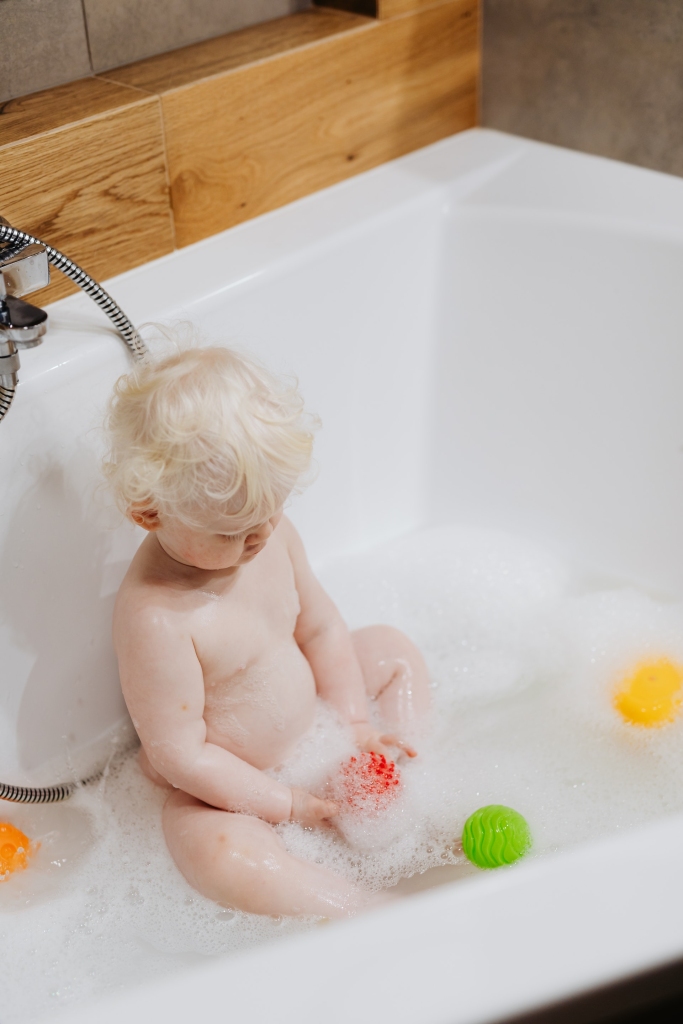
Bathtubs have many advantages. One of the biggest benefits is they often are cheaper to install than showers. Standard tubs cost between $400 and $8,000, depending on the brand you choose and any space constraints. Besides affordability, there are other reasons why having a bathtub in your home benefits you.
Most parents prefer bathing their young children in the tub versus the shower. When only a shower is available it forces parents to get in with their little ones, which can be inconvenient and unsafe. Kids eventually reach an age where it makes them uncomfortable to shower with a parent, but they still can’t navigate the shower without help. Having a bath is a great solution.
There’s nothing quite like a soak in the tub to soothe sore muscles or relax after a long day at work. If you’re among the 1 in 5 Americans who suffer from chronic pain, a bathtub can be your salvation. Toss in some Epsom salts or your favorite bath bombs to enjoy some downtime before bed.
Shower-tub combinations are among the most common type of bathroom fixtures. Not only are they practical, but they also are efficient. Even if your tub and shower are separate, there can be challenges associated with having a bathtub.
Some of the downsides to bathtubs include:
Workarounds like walk-in bathtubs can be used to remedy some of these disadvantages. You can talk to your bath conversion specialist to explore all your options before deciding.
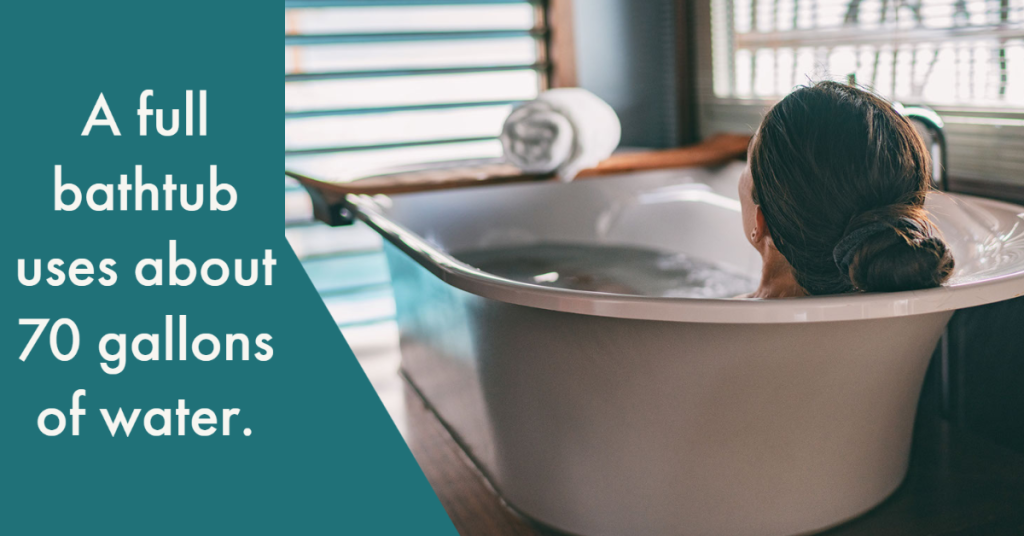
Showers have many advantages for homeowners. They provide easy access to those with mobility issues. Grab bars, non-slip tiles, and benches are among the features easily added to improve shower safety for everyone. Here are some other reasons you may want a shower instead of a bathtub if you must decide between the two.
High-end features for showers are virtually limitless. You can have your choice in fixtures, including monsoon showerheads that mimic the feel of standing in a tropical rainstorm. If you want to get sprayed from all angles, vertical spa systems can do the trick. You can even get a walk-in glass shower, one of the hottest bathroom conversion trends right now.
A full bathtub uses around 70 gallons of water, according to the U.S. Environmental Protection Agency. In comparison, a 5-to-7-minute shower uses between 10 and 25 gallons of water, depending on your shower head.
As previously mentioned, showers aren’t always practical for families with young children. So, that’s a major con. Depending on the size of your bathroom, another disadvantage could be space constraints that make fitting into a stand-up shower challenging for larger people.
Some other downsides to showers include:
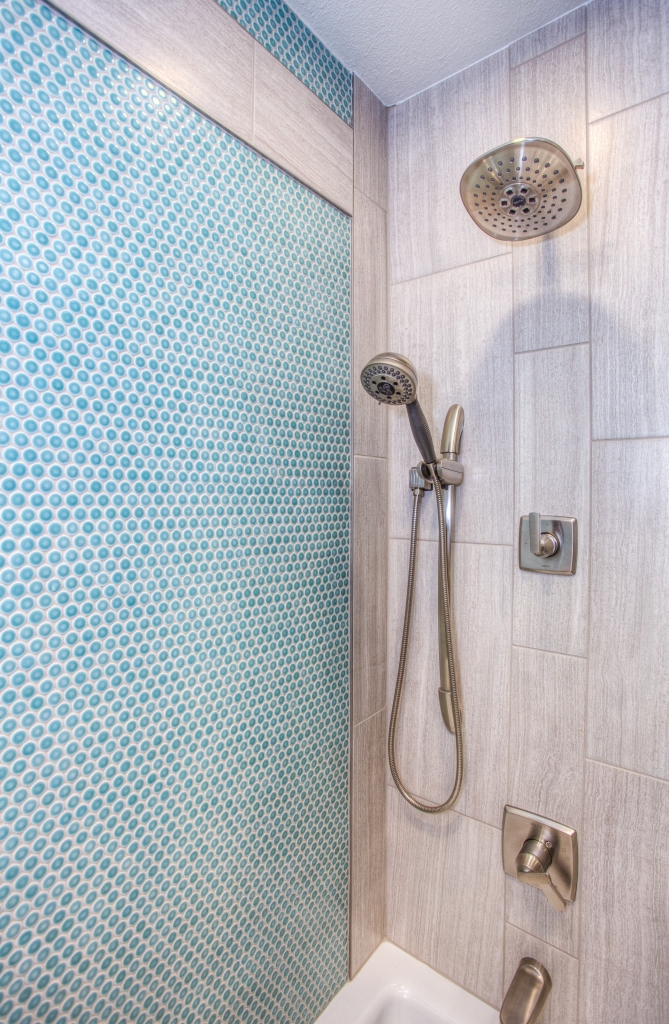
If you can’t decide between a tub or shower, the best solution is to have both. You can opt for a tub-shower combo unit if space is an issue. They are the perfect solution for one-bath homes to increase the functionality of the space. Tub-shower combinations also are more affordable than a separate tub and shower unit.
When space isn’t an issue, you might want to consider keeping the two separate. Working with a bath conversion specialist or tub-to-shower conversion company near you can help you decide which approach works best for your individual needs.
Before you dive into your bath conversion project, it’s best to speak with a bath conversion company near you. Just Bath delivers 5-star design and installation services for all bath conversion customers in the Pittsburgh area. You can rely on our combined 37 years of experience to help you navigate your tub-to-shower conversion or other bath conversion project.
Request a free quote today or schedule your free consultation with one of our design team members. Give us a call at 724-400-2284, send us an email, or contact us online to get started.
Just had my shower re-done and I’m in looooove!! We had it done in an AMAZING color (Alaskan Ivory) and it is absolutely gorgeous! Also, it’s very easy to clean.
We had our bathroom remodeled with Sentrel, we chose to go with the Abalone Travertine and we couldn’t be happier it looks amazing and I and my husband get compliments on our shower all the time. We would recommend them to anyone.
Loved the service, professionalism, but most importantly, the end result. Nicely done.
The difference between the before and after is so drastic that we can hardly believe it is the same bathroom. What a difference! We love it! We are so pleased with our remodeled bathroom and would recommend Sentrel Bath Systems to anyone.
When you gave us the “Dream Bathroom” you promised we were thrilled! We are proud to show our beautiful new bathroom to our friends and relatives. We highly recommend your company to anyone who appreciates quality workmanship done with concern for the customers’ wishes and needs.
My bathroom was a mess and it needed a redo, but I was worried about the expense. I couldn’t be happier with the result. The final cost remained within my budget and my bathroom is finally usable and it looks great.
Just Bath was amazing! Gave us many options and loved what we choose! Install was painless and they left everything clean! The guys did a great job!!
Just Bath was great, they did what they promised to do. Very professional and very polite. I would absolutely recommend them and Just Bath. Thank you all again. Great job guys…